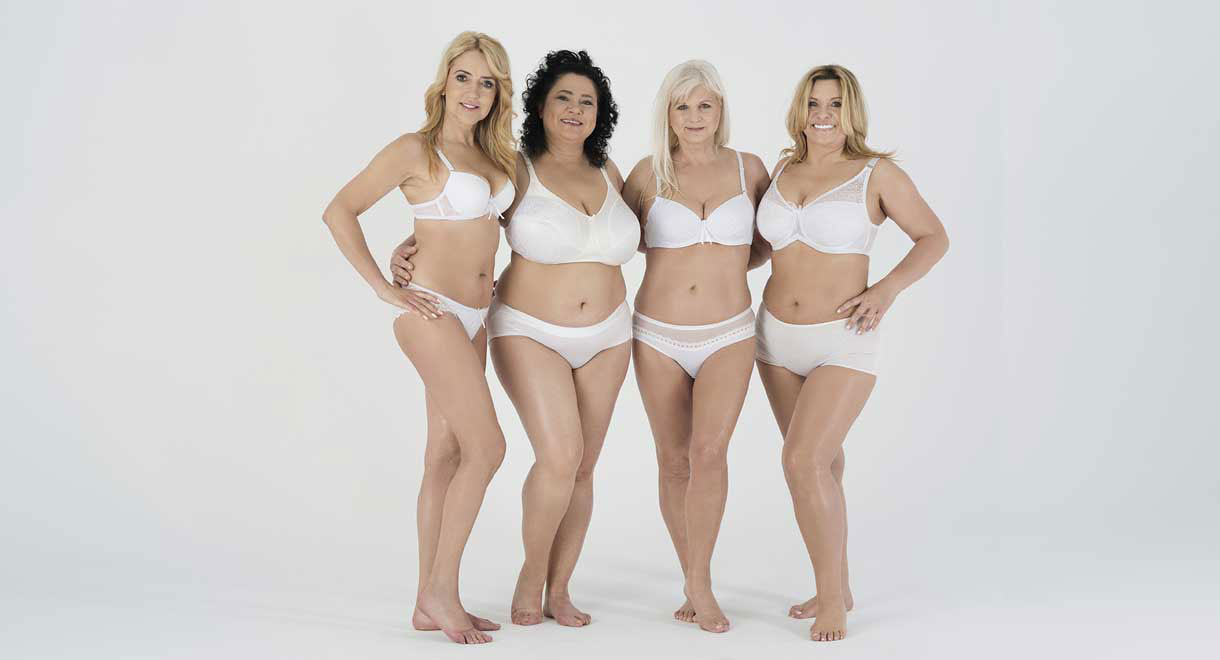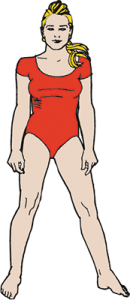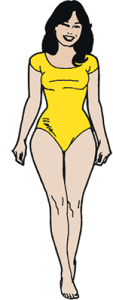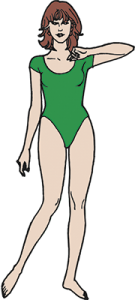

Know Your Body Type
Have you ever wondered?
- Why some people put on weight easily and others don’t
- Why some people put on weight mainly in the lower parts of their body and others only put on weight in their upper body
- Why some people only put on weight in their abdomen
- Why some people can eat whatever they like and as much as they like and hardly put on any weight, whilst all you have to do is look at a pastry and you put on a few ounces
It’s not fair but this article will help you to understand why.
I am sure many people have pondered that. We all have skinny friends who complain they can’t gain weight and yet they eat heaps more fattening foods than you do – it can be curious !
Most people think it’s due to differences in the metabolic rate between individuals, and to some extent that’s true, but it goes deeper than that.
Your tendency to easy weight gain and where you will deposit fat cells is much more related to the type of body shape you have inherited.
Your body shape determines your hormonal and metabolic characteristics and thus where and how you will deposit fat cells.
No one has a perfect body shape and most people have wishes to change parts of themselves. Some women become really ‘hung up’ or unhappy about a part of themselves, so much so, that they allow it to erode their self-esteem and personality. I try to show women that they need to accept themselves as a unique individual with a unique beauty. The next step is to make the best of what you’ve got right now, today! Don’t let life pass you by!
Whether you want to look sexier, slimmer, more athletic, and more or less shapely, the Body Shaping Diet and exercise program can do it for you.
There are hundreds of thousands of diets out there and there are many ways to lose weight. In spite of this, many people fail to lose weight and become yoyo dieters. If you know and understand your body shape this will give you a special advantage in your weight loss journey. There is no other diet published for the four body shapes to follow – this is the only one!
Do not get confused with the Blood Type diet, which excludes many different foods, depending upon your blood type; this is completely different to my Body Shaping Diet. My Body Shaping Diet works on your hormones and metabolism and has nothing to do with your blood type – it’s all about your Body Shape.
It is a specific eating plan, which can be used for the rest of your life. There are four different eating plans tailored for the four different body shapes found in women. All women will fall into one of these four body shapes.
Yes it's fascinating, people love to know what body type they are and they really need to know this - Gynaeoid, Android, Thyroid and Lymphatic.
It’s also fascinating that each of the four body shapes, if exposed to the wrong types of foods on a consistent basis, may become overweight in different areas of their body. Some body shapes can eat so-called ‘fattening foods’ without becoming overweight while other body shapes cannot. Similarly, no one simple calorie restricted diet works for all body shapes because each body shape has a unique metabolic and hormonal make-up.
The Body Shaping Diet matches your body shape and hormonal make-up to the foods that will stimulate and balance your metabolism. This is what makes the Body Shaping Diet so effective, not only in the initial months, but for the rest of your life.
One of my naturopaths in Australia, Vicky Jane Spencer, was a true Gynaeoid Body Type and did not like her pear shape. Through the correct diet and exercise Vicky changed her body shape and looks more like a Thyroid Body Type today. Vicky Jane has written a book called Ageless Vitality and she is a true ambassador for healthy and sustained weight loss and body shaping.
With exercises and foods to match your Body Type, you can lose weight from where you want to, thus sculpting your physique into a more streamlined and balanced form.

THE ANDROID SHAPE
This shape is characterized by a strong, thickset skeletal frame with broad shoulders, a large rib cage and muscular shapely limbs. The neck is muscular, the chest and abdomen are aligned and the pelvis is small so that android women are relatively straight up and down. They lack feminine curves and do not go in at the waist and have muscular buttocks and powerful muscular thighs. Their calves are muscular and their ankles are strong but slim. The pelvis and buttocks do not curve outwards very much below their rather thick waist.

THE GYNAEOID SHAPE
This shape is characterized by a pear shape, with the body contour flaring outwards below the waist around the hips and thighs. The buttocks are curved and rounded and the thighs are curved outwards laterally. The bottom has a tendency to droop downwards over the back of the thighs. The waist is tapered and smaller than the hips giving a feminine appearance. The breasts are variably sized and may be small to large. The shoulders are small to moderate in size.

THE LYMPHATIC SHAPE
The lymphatic-shaped woman is characterized by a generalized thickening and puffiness of the body. This is due to the fact that she retains fluid easily especially in her limbs, which gives her thick arms and legs with a straight up and down appearance along their length. The ankles and wrists are thick and puffy in appearance. The shoulders and rib cage are average in size and the abdomen protrudes in front. The trunk, like the limbs, is relatively straight up and down with a thick waist and moderate outward curves on the buttocks and pelvic area. The breasts may be small or large in size. The bones of the skeleton and the muscles are average to large in size and their shape is not clearly defined, as they are covered by a thickish layer of fat and fluid. In other words it is difficult to see their bone structure and they are definitely not the ‘bony type’ which we find amongst thyroid-shaped women.

THE THYROID SHAPE
The thyroid body type is characterized by a narrow streamlined shape with long limbs and fine bones. The long arms and legs produce a “thoroughbred racehorse look” or a “greyhound look”. The breasts tend to be smallish although they may be moderate in size. Thyroid shaped women are often tall, but even if they are not, they give the impression of being tall because of their long fine limbs. They have a somewhat ‘slender’ figure with a narrow rib cage and small waist and generally only small curves on the buttocks and thighs. They move gracefully and may be athletes, especially sprinters or basketball players, dancers or one of today’s fashion models. Angelina Jolie and Jerry Hall are the epitome of the thyroid shape. Their fingers and toes are long and fine to match their limbs and their necks are long and tend to be narrow. They could be described as ‘willowy’ meaning willow tree like and may have a fragile look about them. Their bones are long, small and narrow and the bone structure is clearly defined beneath a thin layer of subcutaneous fat. They are often bony in appearance with their ribs and bony protuberances (knobs) around their joints being very evident.
Thyroid body types do not have a lot of muscle tissue and do not build muscle easily. They may try to build muscle by working out at the gym and doing weights but they never develop really big strong muscles and thus do not become body builders. They do not have as many fat cells as the other body types, which could partly explain why they do not gain weight easily. Thyroid body types have a high metabolic rate, which makes it harder for them to gain weight.
When the different body types were first described?
Years ago it was recognized that there were different body types and they were categorized according to their shape only. This was before we understood the hormonal and metabolic differences between the body shapes. For your interest, just in case you find them in some old textbook, I will describe them for you.
The Android Body Type was called the mesomorph The Thyroid Body Type was called the ectomorph The Lymphatic Body Type was called the endomorph The Gynaeoid Body Type was not described, probably being considered a combination of several types.
The above statements have not been evaluated by the FDA and are not intended to diagnose, treat or cure any disease.
Know someone who might benefit from this article? Share it!
Need Help?
1-888-75-LIVER
Monday to Friday, 9:00 am to 5:00 pm MST
100%
Satisfaction Guaranteed
If it’s faulty or wrongly described, we’ll replace it.










